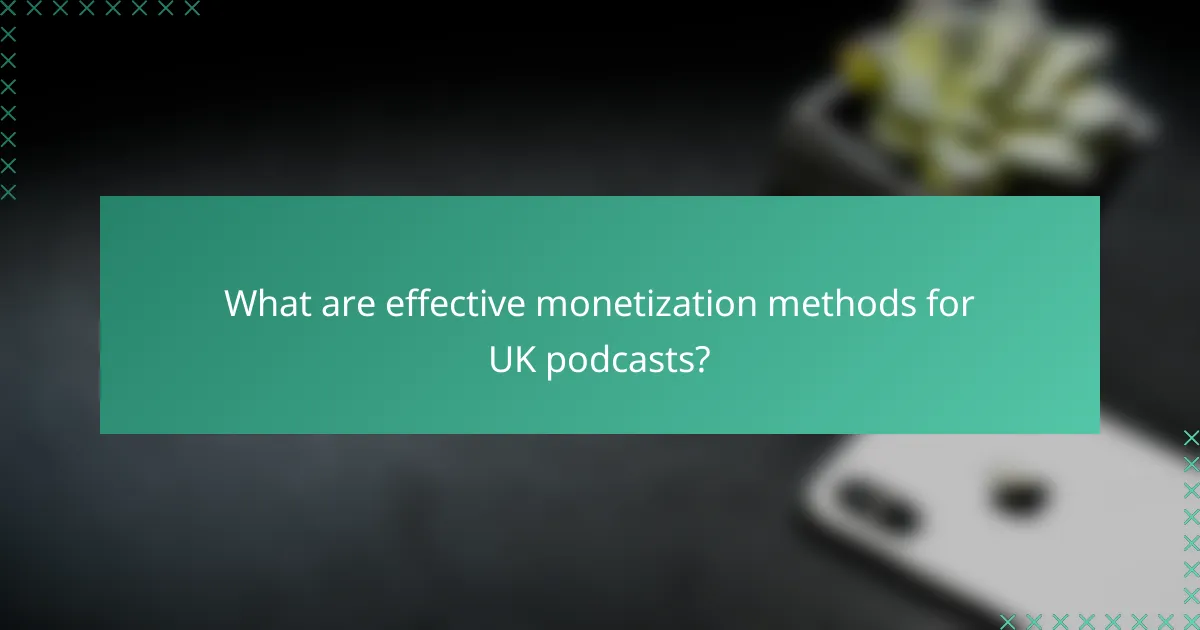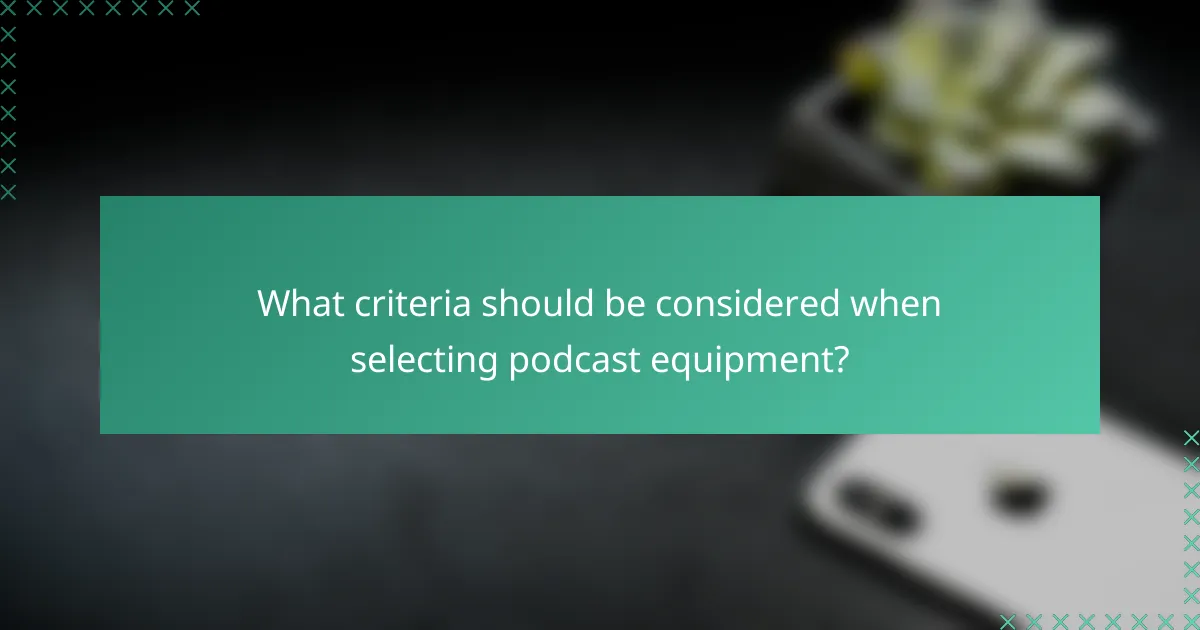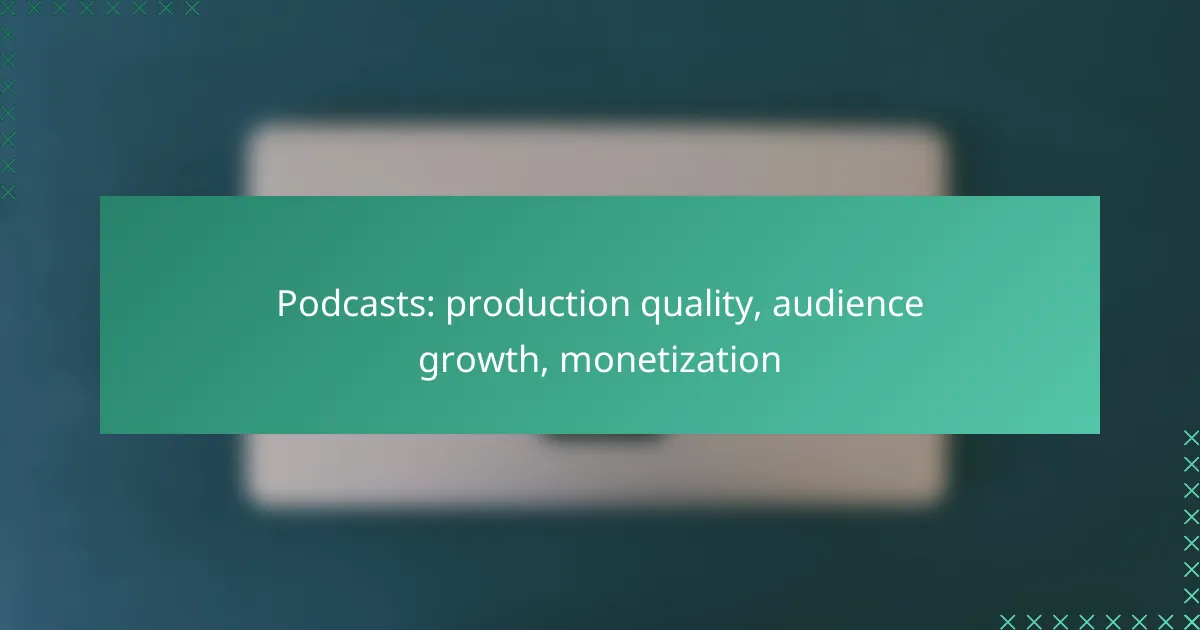Podcasts have become a powerful medium for storytelling and information sharing, but achieving success requires attention to production quality, audience growth, and monetization strategies. By investing in high-quality equipment and techniques, podcasters can enhance their audio clarity and overall listener experience. Additionally, employing effective marketing strategies and exploring diverse monetization options can help creators expand their reach and generate revenue, ensuring the sustainability of their podcasting endeavors.

How to improve podcast production quality in the UK?
Improving podcast production quality in the UK involves investing in the right equipment, software, and techniques to enhance audio clarity and listener experience. By focusing on these key areas, podcasters can significantly elevate their content’s professionalism and appeal.
Invest in quality microphones
Quality microphones are essential for capturing clear and professional audio. Look for condenser or dynamic microphones that suit your recording environment; condenser mics are great for studio settings, while dynamic mics perform well in untreated spaces. Expect to spend anywhere from £50 to several hundred pounds depending on the brand and features.
Consider options like the Shure SM7B or the Audio-Technica AT2020, both of which are popular among podcasters. Investing in a good microphone can drastically reduce background noise and improve overall sound quality.
Use professional editing software
Professional editing software can refine your podcast audio and enhance its overall quality. Programs like Adobe Audition, Audacity, or Reaper offer powerful tools for noise reduction, equalization, and mixing. Many of these options have free trials or lower-cost versions, making them accessible for beginners.
When editing, focus on removing unwanted sounds and balancing audio levels. A well-edited podcast can keep listeners engaged and improve retention rates.
Implement soundproofing techniques
Soundproofing techniques help minimize external noise and echo, creating a better recording environment. Simple methods include using heavy curtains, rugs, and acoustic panels to absorb sound. You can also record in smaller, quieter spaces to reduce ambient noise.
Consider investing in foam panels or soundproofing kits, which can range from £50 to £200, depending on the size of your recording area. These improvements can make a noticeable difference in audio clarity.
Hire audio engineers
Hiring audio engineers can elevate your podcast’s production quality significantly. These professionals have the expertise to mix and master your audio, ensuring it meets industry standards. While this option may increase costs, the investment can lead to a more polished final product.
Freelance audio engineers in the UK may charge between £25 to £100 per hour, depending on their experience and the complexity of the project. Collaborating with an expert can save you time and enhance your podcast’s overall sound.
Utilize remote recording tools
Remote recording tools allow you to capture high-quality audio from guests who are not physically present. Platforms like Zencastr, SquadCast, or Riverside.fm offer features designed for podcasters, ensuring clear audio even over the internet. These tools often provide separate audio tracks for each participant, making editing easier.
When using remote recording tools, ensure all participants have good microphones and stable internet connections. This setup can help maintain audio quality and provide a seamless experience for your listeners.

What strategies drive audience growth for podcasts?
Effective strategies for driving audience growth in podcasts include leveraging social media, collaborating with fellow podcasters, optimizing for search engines, engaging with listeners, and utilizing email newsletters. Each of these methods can significantly enhance visibility and listener engagement, ultimately leading to a larger audience base.
Leverage social media marketing
Social media platforms are powerful tools for promoting podcasts and reaching new audiences. By sharing episode highlights, behind-the-scenes content, and engaging posts, podcasters can attract listeners who may not have discovered their show otherwise.
Consider using platforms like Instagram, Twitter, and Facebook to create a community around your podcast. Regularly posting and interacting with followers can foster loyalty and encourage sharing, which can amplify your reach.
Collaborate with other podcasters
Partnering with other podcasters can introduce your show to their audience, facilitating mutual growth. This can be done through guest appearances, cross-promotions, or even joint episodes that showcase both podcasts.
When collaborating, choose podcasters with a similar target audience to maximize the impact. This approach not only broadens your listener base but also enriches your content through diverse perspectives.
Optimize for SEO
Search engine optimization (SEO) is crucial for making your podcast discoverable online. Use relevant keywords in your episode titles, descriptions, and show notes to improve your visibility on search engines and podcast directories.
Consider creating a website or blog for your podcast where you can publish show notes and articles related to your episodes. This can enhance your SEO efforts and provide additional content for your audience.
Engage with listeners through feedback
Actively seeking and responding to listener feedback can strengthen your community and encourage word-of-mouth promotion. Create opportunities for listeners to share their thoughts through social media, surveys, or dedicated email addresses.
Incorporating listener suggestions into your content can make your audience feel valued and more connected to your podcast, fostering loyalty and encouraging them to share your show with others.
Utilize email newsletters
Email newsletters are an effective way to keep your audience informed and engaged. Regular updates about new episodes, exclusive content, and upcoming events can help maintain listener interest and encourage repeat listens.
Consider offering incentives for newsletter sign-ups, such as bonus content or early access to episodes. This can help grow your email list and create a dedicated channel for communication with your audience.

What are effective monetization methods for UK podcasts?
Effective monetization methods for UK podcasts include sponsorship deals, premium content subscriptions, affiliate marketing, merchandise sales, and hosting live events. Each method has unique advantages and considerations that can help podcasters generate revenue while engaging their audience.
Implement sponsorship deals
Sponsorship deals involve partnering with brands to promote their products or services during podcast episodes. Podcasters can negotiate rates based on audience size, engagement, and niche relevance. Typically, sponsorships can range from a few hundred to several thousand pounds per episode, depending on the podcast’s reach.
To attract sponsors, ensure your podcast has a clear target audience and consistent download numbers. Create a media kit that outlines your listener demographics, engagement metrics, and potential sponsorship packages.
Offer premium content subscriptions
Premium content subscriptions allow listeners to access exclusive episodes, ad-free content, or bonus materials for a monthly fee. Platforms like Patreon or Apple Podcasts Subscriptions can facilitate this model, with prices often set between £3 to £10 per month.
When implementing subscriptions, clearly communicate the value of the premium content. Consider offering a free trial or introductory pricing to encourage sign-ups and retain subscribers by consistently delivering high-quality, exclusive content.
Utilize affiliate marketing
Affiliate marketing involves promoting products or services and earning a commission for each sale generated through your referral links. Podcasters can integrate affiliate links into their show notes or mention them during episodes, making it easy for listeners to make purchases.
Select affiliate programs that align with your podcast’s theme and audience interests. Popular platforms include Amazon Associates and ShareASale. Ensure transparency by disclosing affiliate relationships to maintain trust with your audience.
Sell merchandise
Merchandise sales can provide an additional revenue stream by offering branded products such as T-shirts, mugs, or stickers. This not only generates income but also promotes your podcast and fosters community among listeners.
Consider using print-on-demand services to minimize upfront costs and inventory risks. Promote your merchandise through your podcast and social media channels, and create limited-time offers to encourage purchases.
Host live events
Hosting live events, such as podcast recordings or Q&A sessions, can create a unique experience for your audience while generating revenue. Ticket prices can vary widely, typically ranging from £10 to £50, depending on the event’s scale and location.
To successfully host live events, choose a venue that suits your audience size and promote the event through your podcast and social media. Consider offering exclusive merchandise or meet-and-greet opportunities to enhance the experience and incentivize attendance.

What criteria should be considered when selecting podcast equipment?
Selecting podcast equipment involves evaluating several key criteria, including budget, content type, and audience needs. These factors will help ensure that you choose the right tools to produce high-quality audio that resonates with your listeners.
Budget constraints
Your budget is a primary consideration when selecting podcast equipment. Entry-level setups can start as low as $100, while professional-grade gear may exceed several thousand dollars. Determine how much you can invest without compromising your overall production quality.
Consider not only the initial purchase price but also ongoing costs such as software subscriptions and maintenance. It’s often wise to allocate funds for essential items like microphones, headphones, and audio interfaces, while saving on accessories that can be upgraded later.
Type of content produced
The type of content you plan to produce significantly influences your equipment choices. For instance, narrative-driven podcasts may require high-quality microphones and soundproofing, while interview formats might benefit from portable recorders for on-the-go interviews.
Think about the recording environment as well. If you’re recording in a noisy area, investing in dynamic microphones that minimize background noise can improve audio quality. Tailor your equipment to match the specific demands of your content style.
Target audience needs
Your target audience’s preferences and listening habits should guide your equipment selection. If your audience listens primarily on mobile devices, ensure your audio quality is clear and crisp, as poor sound can lead to disengagement.
Engage with your audience to understand their expectations. Consider conducting surveys or monitoring feedback to identify any specific audio features they value, such as clarity, volume levels, or even the type of music used in your podcast.
